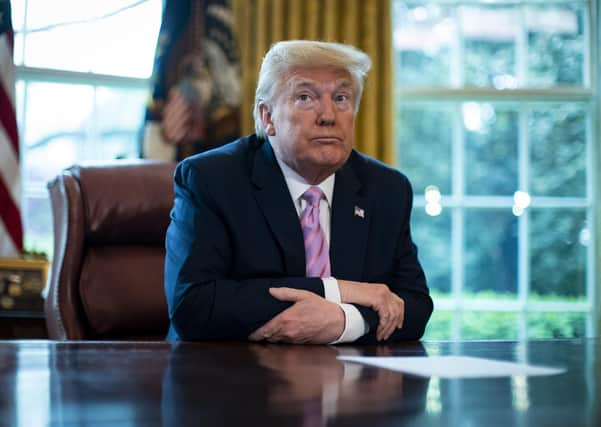Here’s why Donald Trump can win re-election by stoking racism – Henry McLeish


Donald Trump’s victory in 2016 shocked the political world and established the most bizarre and crisis-ridden presidency in living memory. But how did it happen?
Trump destroyed a strong field of 17 candidates to win the Republican presidential nomination and exploited to the full the weak campaign of Hillary Clinton, a lacklustre candidate, despite her distinguished political career.
Advertisement
Hide AdAdvertisement
Hide AdCandidate Trump knew he could easily exploit the weaknesses and corruption in American politics and its democracy. He also recognised an issue that was dangerous, divisive, potentially incendiary, but which would become his most important political weapon: race and the fear of it.
Only someone with Trump’s unique character could handle such a strategy. Trump had form with a record of racial scrapes, slurs and legal cases. This has been painstakingly recorded by journalists and biographers.
While Rex Tillerson, former US Secretary of State, described Trump as a “f****** moron”, others more kindly have described him as amoral. Without shame, regret, empathy or a sense of right or wrong, the presidential candidate could say anything about race and ethnicity, without suffering any sense of personal embarrassment or discomfort.
Keeping alive the fear of the white majority becoming a minority in the next 30 years was crucial in keeping his base – of white, older, less educated and evangelical Christian Americans – focussed on the idea that people of colour posed a threat in terms of crime, illegal immigration, terrorism and voter fraud, and would eventually control the US.
Setting aside the key themes of nationalism and isolationism, race is crucial. There is a focus on nativism, xenophobia, Islamophobia and religious intolerance. Subsequent rants and insults, thrown at minorities at pre-election rallies, represent this continuing theme.
For Trump, to keep his base close, African Americans, Native Americans, Asians and Hispanics must be the enemy. The idea of the “scapegoat” is the glue that binds his base.
Trump sensed that minorities were mistrustful of Republicans and that by indulging an anti-minority approach, he would lose few votes and this has certainly proved to be the case.
Fanning flames of hate
Crucially, Trump is transactional. He just wanted to be President, with few policy ambitions, other than serving himself, family and friends. Personal vanity and the lure of “show time” was everything. He put together a coalition of interest groups who could deliver blocks of votes in return for preferential treatment. White evangelical Christians, the gun-lobby, climate change deniers and corporate lobbies help the Republican Party and were rewarded for their efforts, by way of support for Israel and being anti-Iran, no restrictive gun laws, weakening pollution emission standards and tax cuts for the wealthy.
Advertisement
Hide AdAdvertisement
Hide AdThrough this prism, people of colour had nothing to offer. So why would Trump agonise over tackling race and racism?
What is disturbing is the deliberate abuse of minorities to fan the flames of hate and reinforce the negative idea of “lesser people”.
It is hard to imagine a candidate, now the President, and a Republican Party, at war with nearly 40 per cent of Americans, exploiting fear about race as a deliberate act and now using it as a basis for foreign policy and voter suppression.
Evidence from the 2016 election confirmed both the hopes and fears of Trump. Minorities supported Clinton in huge numbers, including 90 per cent of African Americans, 66 per cent of Hispanics, and 65 per cent of Asians. She only received 37 per cent of the white vote. In contrast, Trump received 57 per cent of the white vote. Only two per cent of African American women voted for him.
Helping Trump was the fact that 73 per cent of white voters turned out, compared to African Americans (57), Hispanics (46) and Asian (49).
The prediction that by 2045 white people will be a 49 per cent minority in America impacted white voters as “race anxiety”; the white population was 80 per cent in 1980. Of the 250 counties in the US with the largest white population, 249 of them voted for Trump in 2016.
In contrast, Clinton’s chances of victory were undermined by a seven per cent decline in the African American vote compared with Barack Obama’s performance in 2012. This could have been caused by voter suppression, the fact that Clinton’s appeal to black voters was much less than Obama or it could have been Russians on social media.
The Mueller report helped indict 13 Russian trolls and revealed evidence showing disinformation cells trying to discourage black voters in key states by using hashtags such as “Killary” and “Wake Blacks” to insult and undermine her credibility in black communities.
Broken democracy
Advertisement
Hide AdAdvertisement
Hide AdWhatever the reasons, the reduction in the number of black votes was significant. In three key battleground states, Wisconsin, Pennsylvania, and Michigan, Trump’s margin of victory was only 100,000 votes over the three states.
Only five times in history has a candidate lost the popular vote, but won the electoral college and become President. Clinton won the popular vote by three million, but lost swing states partly because of race making a difference.
Only 56 per cent of US electors voted in 2016, so 75 per cent of all US adults didn’t support Trump. His victory shows what a broken democracy looks like.
But his grand strategy – stoking fear in white counties, discouraging and suppressing black votes, demonising race and ethnic origin as enemies of America, relegating minorities as scapegoated others – won. True to form, Trump has continued his racist rampage throughout his term of office.
The President’s words and actions have humiliated Mexicans, imprisoned migrants and their children, suggested a moral equivalence between white supremacists and people protesting against racism, referred to El Salvador, Haiti and African countries as “s***holes”, urged Democratic Party House Representatives of colour, born in America, to return to their own countries, ordered a travel ban from specific, but mainly Islamic, countries, verbally abused and stereotyped black female reporters and ridiculed Native Americans, in particular, the Cherokee tribe over their historic “Trail of Tears”.
Trump’s 2016 campaign, built on race, was designed to divide America. These ideas have dominated his presidency. There is nothing in Trump’s character to think he will change as the 2020 election approaches. Race matters in America and Trump knows this.
Comments
Want to join the conversation? Please or to comment on this article.
